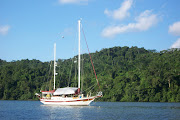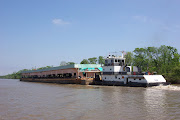We like to take some time at the end of a cruise or during a pause in a cruise to report on the equipment we have installed in preparation for traveling the waterways. If you have followed our blog for any length of time, you know we post each installation, upgrade and repair we do to Beach House in hopes that other boaters will find the information useful. These Project Posts are the most read and most popular on the Blog, so it only makes sense to let you know how things are holding up, what works and what was an absolute failure. Finding quality equipment and parts for a boat is getting more and more difficult as manufacturers look for ways to cut costs, and as a result, the quality declines. It's also the trend to add more and more bells and whistles to everything, and to use the latest and greatest in technology to justify the increasingly higher costs for equipment. This makes many of our electronics more difficult to understand and also adds to the possibility of failure as new features are added. We're still of the KISS mind set (keep it simple, stupid), but we also appreciate advancements that actually serve a purpose and make our boating experience safer and more enjoyable. So let's do an update of our equipment.
If Your Mate Has a Stroke Can You Help?
I know that's a scary question and not a subject you usually find here on our blog. One of the big "What if" questions that often goes through our mind when cruising revolves around what we would do if a medical emergency arises. First and foremost, would we recognize the signs, and then, would we know what to do. As our fellow boaters, us included, approach our golden years, the potential issues change in our minds. Early on, our concern was getting injured, but in these later years, it turns more to potential serious health problems. The real possibility was brought to mind by a recent article written by Keith Murray and published online at http://the-triton.com . It is with their permission that we re-post the article here for your thoughts and consideration. We hope you find it as informative as we did...
I have written about this topic before,
but it’s all I can think about today. When I conduct onboard CPR, AED and first
aid classes, we always review the signs and symptoms of a stroke. It’s
important to recognize those signs so you can help someone having a stroke.
My father just had a stroke last
weekend. Fortunately, it looks like he is going to make a full recovery.
When reading this column today, please
ask yourself if you would know what to do if someone you loved were having a
stroke, heart attack or other medical emergency. Could you help them? Could you
recognize the signs of a stroke? Do you know how to treat a stroke victim? What
would you do if a crew mate began to slur his words, appeared confused or not
walking well?
A stroke is a life-threatening medical
emergency that can cause paralysis, coma and death. It is the brain's version
of a heart attack. A stroke occurs when a blood clot blocks a blood vessel,
interrupting blood flow to an area of the brain (ischemic stroke) or an artery
bursts and blood leaks into brain tissue (hemorrhagic stroke).
Think of a stroke as a plumbing problem
at home or onboard. Either your pipes are blocked with rust (plaque) or the
pipe is leaking.
When either of these occurs, brain cells
begin to die and brain damage occurs. Where the damage to the brain occurs and
how much of the brain is damaged will determine which symptoms the person will
display.
Here are some typical symptoms that you
may observe:
Sudden numbness or weakness of the face,
arm or leg, especially on one side of the body
Sudden confusion, trouble speaking or
understanding
Sudden trouble seeing in one or both
eyes
Sudden trouble walking, dizziness, loss
of balance or coordination
Sudden, severe headache with no known
cause
It should be noted that women may
experience symptoms that are different from men. Those may include sudden face
and limb pain, sudden hiccups, sudden nausea, sudden general weakness, sudden
chest pain, sudden shortness of breath, and sudden palpitations.
If you think someone may be having a
stroke, act F.A.S.T. and do this simple test:
F -- Face: Ask the person to smile. Does
one side of the face droop?
A -- Arms: Ask the person to raise both
arms. Does one arm drift downward?
S -- Speech: Ask the person to repeat a
simple phrase. Is their speech slurred or strange?
T -- Time: If you observe any of these
signs, get medical attention immediately.
Though it is not part of the test, note
the time when the symptoms first began. There is only about a three-hour window
for a clot-busting medication to be given at the hospital. It is very important
that the stroke victim get to a hospital as quickly as possible.
A TIA, or transient ischemic attack, is
called a "warning stroke" or "mini-stroke". This type of
stroke produces stroke-like symptoms but generally has no lasting damage.
Recognizing and treating TIAs may reduce the risk of a major stroke. Often TIA
symptoms are the same as those of a stroke, only temporary. The short duration
of these symptoms and lack of permanent brain injury is the main difference
between TIA and stroke.
The best way to help someone having a
stroke is to recognize that they are indeed having a medical emergency and
getting them to a hospital as quickly as possible. Stay with the victim, place
them in a position of comfort, and monitor their breathing and consciousness.
To learn more about stroke warning signs
and other medical emergencies, take a CPR, AED and first aid class. Ideally, everyone
should take a refresher class at least every two years. Often classes can be
conducted at your location, on your boat, or at your business.
Shipboard classes are helpful because
they allow the crew to develop plans, review first aid supplies, and talk about
medical emergencies as they relate to their surroundings, crew, passengers and
the various ports of call.
The American Heart Association has a
good 60-second video that everyone reading this should watch. And send the link
to a friend. It may help someone save a life. Visit
http://strokeassociation.org, click on the FAST box on the right side, then
scroll down to the FAST Body Language PSA box.
Keith Murray, a former firefighter EMT,
owns The CPR School, a first-aid training company. He provides onboard training
for yacht captains and crew and sells and services AEDs. Contact him at
877-6-AED-CPR, 877-623-3277 or www.TheCPRSchool.com. Comments on this column
are welcome at editorial@the-triton.com.
Is Facebook Really for Boaters?
We think so. There are several very active boating groups on Facebook with a lot of knowledgeable people who can provide answers, insights and even some humor when answering many boat related questions. There's something for everyone, from the novice to the old salts. If you haven't visited our Facebook page lately, or not at all, we've posted lots of great information, news and, we think, wonderful photos to enjoy. Just some of what you will find there...
- Our Gulf Coast Photos for the Florida west coast and Panhandle (more coming)
- The latest on the Florida anchoring issue
- News and reports from the U.S. Coast Guard
- Navigation reports
- Articles of interest to boaters
- Wildlife on the waterways
- Current boating news
- Lots More
- Links to our videos
Give us your thoughts on Facebook. Post in Comments.
Subscribe to:
Comments (Atom)
















